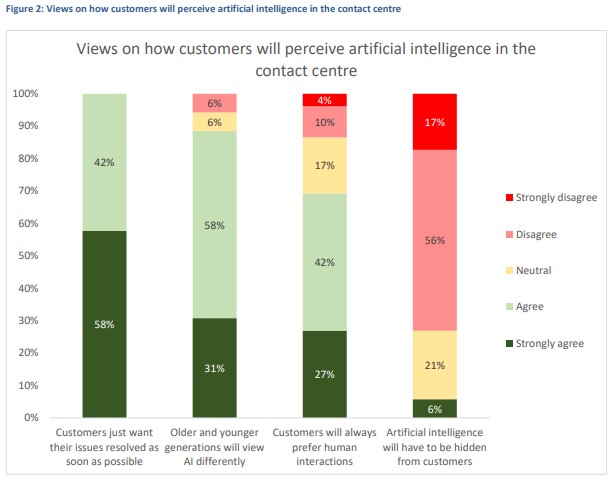
Why Chatbots, Voicebots & Conversational AI are the key to improving Self-Service
Summary of Inner Circle Report, ContactBabel, March 24
According to the latest research1 by UK analyst ContactBabel there is an unanimous belief that AI, including conversational-AI and also generative-AI, will play a significant part in delivering customer service in the future, both supporting live or human agents, but more significantly by improving customer self-service.
The findings suggest overwhelmingly that customers will accept non-human assistance if it is convenient, assessable, and in particular where self-service means that the customer can avoid the main bug-bears of traditional customer service.

The report examines 4 key challenges of traditional customer service and highlights how technology including Chatbots, Voicebots and Conversational-AI help to resolve them.
1. Reducing excessive call waiting and customer queues
The report found that based on a survey of 1,000 UK customers a short queue time is perceived as the most important factor influencing positive customer experience. Industry insights show that some sectors including, utilities, public sector and housing are reporting extremely long call wait times.
Excessive queues are the number one factor driving a negative customer experience for the majority of businesses, therefore – as the report points out – improving self-service options for customers is an absolute priority, and AI-enabled voice and chat are part of that solution.
2. Improving the uptake and effectiveness of web self-service
Many businesses are already reaping the benefits of using chatbots (usually to handle less complex enquiries and FAQs) and the report highlights that the use-case for more sophisticated AI-enabled assistants, able to handle more complex enquiries, is very clear. Based on the research almost two thirds of live-calls which could be handled through web self-service if both the customer was confident and also if the automation solution was capable.
But how do you get there? Guidance for businesses looking to adopt more automation and self-service is summarised below:
- Advanced conversational AI chatbots can now handle more complex customer queries by understanding context and intent, rather than just searching for keywords. This helps deflect calls to live agents for issues that can be resolved through self-service.
- Sophisticated AI-powered digital assistants can seamlessly escalate queries to live agents when needed, while passing along the conversation history to enable a smooth handoff. Additionally, the resolved queries can be used to continuously improve capabilities with generative AI and machine learning.
- Most importantly, to maximize the benefits of sophisticated chatbots, businesses need to educate customers to use natural language interactions, rather than just keywords.
Businesses should also focus on building customer trust by providing reassurances, and proactively demonstrating the value of the self-service channel.
The key for businesses is to leverage the advanced capabilities of modern conversational AI to drive effective self-service, while ensuring a positive customer experience that encourages stickiness and therefore ongoing use of the self-service.
3. Improving voice based self-service (alternatives to IVR)
A typical self-service IVR (Interactive Voice Response) solution works on the assumption that the majority of customer enquiries can be solved by offering a limited number of solutions or options. This works well in cases where the caller has a simple request (e.g. speak to a sales agent or get a balance update) but often fails where there is a complex requirement.
The report illustrates that that there are two main business challenges using IVR:
1. Self-service via IVR is not as effective as it could be.
2. Call routing is a painful (and sometimes ineffective) experience for the customer with numerous dropped calls.
AI-enabled voicebots can provide a solution to both of these issues. A voicebot provides flexibility, it can be viewed as a chatbot client on a smarphone or device that customers communicate with through voice rather than typed text. The best solutions have the capability to handle natural language, to use artificial intelligence to determine intent and provide solutions, and are able to convert speech to text and back again.
Definitions differ, but whereas an IVR (whether speech-enabled or not) is restricted by human programming to achieve outcomes based on specific patterns and inputs, an AI-enabled solution can have conversations with customers to determine even multiple intents, and deliver a far wider range of personalised information and services. Crucially, it can learn from experience!
4. Reducing the cost of customer authentication
The research provides detailed, and thought provoking insight into the cost of customer authentication to UK businesses, reporting that across industries a mean average of 76% of all inbound calls require caller identity verification of some kind. Not surprisingly, the costs to manage this are staggering, a live agent might take up to 80 calls per day talking customers through mundane and repetitive security questions (that’s around 45 minutes of call time).
From their research Contact Babel has calculated that the overall cost of agent-handled security and identity checking is over £2.19bn per year in the UK.
The report further explores that while large enterprises, including banks have been able to invest in dedicated authentication solutions, for the most part these solutions are too expensive for the majority of businesses. However, with more sophisticated voice-based AI solutions now becoming available improving and automating customer authentication is a recommended priority for mid-size organisations.
Conclusion
The ongoing evolution of AI-powered self-service solutions means that as the range of subjects and depth of knowledge handled by chatbots, voicebots or digital assistants becomes increasingly sophisticated it will bring a positive effect to business performance and also customer experience.
With around 25% of calls being from customers who have tried – and failed – to resolve their issues online, the opportunity for improving performance and CX through implementing and developing self-service is huge.
You can read the full report here and if you’d like to learn more about how AI-powered voice or messaging self-service could help you to achieve your business goals then please get in touch or call us on 0333 6000 360.
Sources:
- The Inner Circle Guide to Chatbots, Voicebots & Conversational AI, ContactBabel 2024
More blogs
converse360 Launches Live Chat
November 27, 2025







